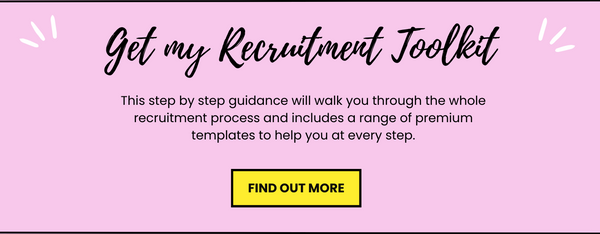How to hire your first employee, in 5 easy steps

If you're a UK entrepreneur, who's never hired an employee before, it can be an exciting but daunting task. 🙄 If you've done the think and you're ready to hire someone ASAP, here's 5 simple steps to get you making a job offer. 😀
1. Create an effective job description
Once you have assessed the needs and scope of the role you are recruiting for, you need to ensure your job description is a true reflection of what you need. You should be as honest as you can in the job description, ensuring the people applying for your role know exactly what would be expected of them in the role, along with clear requirements of their experience and background you desire in your ideal applicant.
Your job description should be informative, tell the applicant about your company and what you are looking for in the successful candidate.
You should also tell prospective candidate’s what you will offer them in return, this will include the salary, along with benefits you will be offering. A popular one for some of the smaller companies I have worked with are unlimited holiday entitlement or an ability to work flexibly.
Have a think about what you are offering and add this to your job description. Remember, you are selling your role and company as a great place to work so make sure you add in all the great things about working with you.
2. Advertise your job to get it seen by your target audience
Once you are happy with your job description, you need to advertise the role.
Job boards are a brilliant place to start and many popular ones also offer introductory offers. You can also be creative with where you advertise your roles, for example you could write a post on your LinkedIn, Facebook, Twitter or Instagram profile. If you’re looking for a graduate advertise it on University job boards (and that’s free too!).
To attract the right candidates for the role, you will need to ensure you are advertising in places they are likely to see, the best place to advertise your job posting will depend on your industry and the nature of the role.
It is also helpful to be clear about the method of application (most commonly it is CV and covering letter) and set an end date on your job advert. This ensures that interested candidates know when they need to have applied and in what way.
3. Create a shortlist of people to interview
Once you have advertised your role, you should start to get applications. These will vary, some will be along the lines you are looking for, but you may receive some they are not suitable (e.g. due to lack of experience or qualifications).
You need to sift through these and reject the ones that are not suitable and short list your top (I would recommend 4-5 candidates to meet at the interview). It is helpful to have more than 1 or 2 candidates, so you can compare and find the best person to offer the role too.
4. Interview the shortlisted candidates
I would recommend using a set interview bank of questions that each candidate is asked. By asking everyone the same questions, you will be able to compare their answers to find the one that is best matched to the role, and that matches the values of the company.
Remember the person you hire will represent your business, so you need to make sure you are recruiting the kind of person who can do this, and help you to grow and develop your business as you require.
In my experience, it’s best to hire for attitude rather than skill, you can always teach certain skills, but the attitude cannot be changed so easily. 😇
I recommend that employers ask candidates to bring along a copy of their passport to an interview. The reason is that it will be needed if they are successful to prove they have the right to work in the UK. By asking them to bring this to an interview, you can be assured they are eligible to work in the UK.
It is the worst feeling to interview someone you think is great, be ready to make an offer an realise they are not entitled to work in the UK and you need to pay a lot of money to sponsor them if you've not budgeted for that ☹️
Make sure you give the candidates a chance to ask you any questions about the role, this is a great way to understand how much research they have done into the role and the company. This is also important, because an interview is a 2-way process, yes it is for you to see if the candidate fits the role and requirements, but it’s also a chance for the candidates to understand if this role is for them.
5. Make a job offer to the best candidate
This is the fun part, offering to the candidate who you think is the right one for the role.
I would suggest a verbal offer is made over the phone, and followed up with a job offer letter, employment contract and all the paperwork for the candidate to sign and return to you. The contract of employment will confirm the details of the offer, such as the job title, start date, notice periods, probation periods, details of benefits offered etc.
Remember to also contact the unsuccessful candidates and tell them why they weren’t successful, this feedback may be invaluable for them in finding their ideal role and is important from an employer brand perspective. You don’t want them telling their connections that they weren’t even given feedback in their rejection email or call.
Ready to build your dream team?
My Recruitment Toolkit is for UK small businesses wanting to hire their first employee. It includes everything you need to create a great hiring process.







